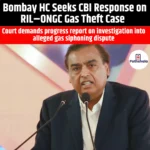Bombay HC Seeks CBI Response on RIL–ONGC Gas Theft Case
|
General Studies Paper II: Transparency and Accountability, Important Institutes |
Why in News?
The Bombay High Court has recently sought a response from the CBI on a petition accusing Reliance Industries Limited and its Chairman Mukesh Ambani of siphoning natural gas worth $1.55 billion from ONGC fields.
Background of the RIL–ONGC Gas Dispute
- Block Allocation: The deep-sea area in the Krishna‑Godavari Basin off the coast of Andhra Pradesh was regarded as highly promising for natural gas. In around 2002-03, the private company Reliance Industries Ltd. (RIL) secured rights under the New Exploration Licensing Policy (NELP) to explore the block known as KG-D6. Meanwhile the state-owned Oil and Natural Gas Corporation (ONGC) held adjoining blocks in the same basin.
- Early Dispute: RIL began commercial production from its KG-D6 block around 2009. It drilled wells close to the boundary with ONGC’s block while ONGC’s development of its adjoining block lagged behind. By about 2013, ONGC raised concerns that gas was flowing (“migrating”) from its block into RIL’s wells because of the connectivity of the reservoir.
- Gas Migration: An independent consultant, DeGolyer and MacNaughton (D&M), in 2015 confirmed there was connectivity between ONGC’s block and RIL’s block and that migration had occurred. In this case no formal unitisation pact existed before production. Consequently RIL’s extraction from its block allegedly included gas that originally belonged to the adjoining ONGC block, according to the government.
- Regulatory Actions: In 2014 the government was alerted when ONGC formally complained that RIL had drilled wells near the common boundary and exploited gas belonging to ONGC.
- By 2015 a committee under former Chief Justice A.P. Shah was constituted to examine the issue and quantify any unfair enrichment by RIL. That committee found in 2016 that RIL had benefited from gas migration and recommended compensation to the government.
- In 2016 the Ministry of Petroleum and Natural Gas issued a demand to RIL and its partners (BP Plc, Niko Resources) of about US$1.55 billion for gas migrated from ONGC’s block during 2009-16.
- In July 2018 a three-member arbitration tribunal sided with RIL and its partners and dismissed the government’s claim, holding that the Production Sharing Contract permitted extraction from wells within the block.
- On 14 February 2025, the Delhi High Court set aside that arbitration award, holding it violated Indian public policy and that RIL had engaged in unauthorized extraction of government resources.
-
- In March 2025, the ministry increased the demand to ₹24,850 crore, which RIL called “unsustainable.” And in May 2025, RIL-BP appealed to the Supreme Court.
The Bombay High Court’s Recent Intervention
- On 4 November 2025, the Bombay High Court formally issued notices in response to a petition filed by Jitendra P Maru. The petition seeks direction to the Central Bureau of Investigation (CBI) and the Union of India to launch a criminal investigation into alleged gas theft by Reliance Industries Limited (RIL) and its directors from Oil and Natural Gas Corporation (ONGC).
- The High Court’s notice to the CBI and Union of India reflects the fabric of the petition which places jurisdiction in the Mumbai-based Bengaluru bench of the Bench of Justices A S Gadkari and Ranjitsinha Raja Bhonsale. The Court found it necessary to ask the CBI to respond because the petition demands not just civil relief but criminal investigation and apprehension of directors.
- The High Court scheduled the next hearing of this petition for 18 November 2025. The notice itself does not determine guilt or liability. Instead it initiates a process of judicial oversight over whether a formal probe is warranted under criminal statutes.
Similar Disputes in India’s energy sector
- Coal India Limited (CIL) – Abuse of Dominance in Coal Supply:
-
- In 2017 the Competition Commission of India (CCI) found that Coal India Limited (CIL) and its subsidiaries had abused their dominant position in the market for non-coking coal supply.
- Several state power generating companies from Gujarat, Madhya Pradesh, Maharashtra and West Bengal alleged that CIL’s pricing and supply practices adversely affected their cost of generation and competitiveness.
- The CCI penalised CIL and directed remedies; the matter then travelled through appeals and proceedings under competition law.
- Gujarat Urja Vikas Nigam Ltd (GUVNL) – Power Purchase Agreement Dispute:
- Essar was alleged to have diverted more power than contractually agreed to its other group entity, thereby reducing GUVNL’s entitled
- In September 2025 the Supreme Court of India restored a Regulation Commission’s order (from 2009) that held Essar must reimburse fixed charges for the diverted portion and compensate for the shortfall in supply.
What can Happen Next in the RIL–ONGC Gas Theft Case?
- Right now, the Bombay High Court has only issued a notice. This notice is like an official summons asking responsible parties to present their side before the Court. The next hearing, scheduled for 18 November 2025, will decide whether the case has enough merit for further judicial or investigative action.
- The notice is a “returnable” one, which means that the respondents must submit their replies or explanations by the next hearing date. The CBI has to clarify whether it intends to take up the investigation and how it views the allegations of gas theft. If RIL or any other party fails to respond, the Court can initiate action for contempt of court.
- If evidence supports the charge of unauthorized extraction, RIL and its directors may face criminal liability under sections related to cheating, criminal breach of trust, and misappropriation of public resources. Financial recovery could also be pursued, which might benefit ONGC by more than ₹13,700 crore.
- If the case progresses into a formal investigation, it could push the government to strengthen resource monitoring frameworks, adopt stricter oversight for offshore gas fields, and ensure clear unitisation policies for adjoining blocks. It may also encourage greater transparency in the dealings between state-owned and private entities.
- Such an outcome would not only be a financial or legal issue but also a test of corporate governance in India’s energy sector. It would raise new questions about how natural resources are managed between public sector undertakings (PSUs) and private players.
|
Also Read: ED Seizes ₹3000 Crore Worth of Assets Linked to Anil Ambani |










